WATERPROOF FABRICS
Waterproof Fabrics and Water-Resistant Fabrics
Waterproof fabrics and water-resistant fabrics are often confused with each other. This small detail can lead to production errors.
Water-Resistant Fabrics
Water-resistant fabrics are fabrics that gain temporary water-repellent properties during production through weaving techniques or through chemical treatment afterwards, depending on the usage conditions.
Waterproof Fabrics
Waterproof fabrics do not allow any water to pass through thanks to the fabric structure and the applied coating process. They provide long-lasting usage opportunities as long as there are no tearing, puncturing, or sudden temperature changes according to usage conditions.
Water-Resistant Fabrics and Waterproof Fabrics
The most prominent common feature of water-resistant fabrics and waterproof fabrics is their ability to provide insulation against wind and breezes.
Generally, polyester or other types of synthetic yarns are preferred in the production of waterproof fabrics and water-resistant fabrics.
Generally, natural or synthetic fabrics that have been treated with or coated with a water insulation material such as rubber, polyvinyl chloride (PVC), polyurethane (PU), silicone, fluoropolymers, and wax gain waterproof properties. The treatment of the fabric is obtained during or after manufacturing. Examples include rubber fabrics used in jackets, sauna suits, and inflatable boats. Additionally, waterproof fabrics can be optimized with water insulation spray.


